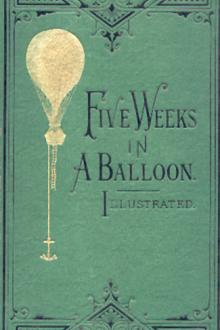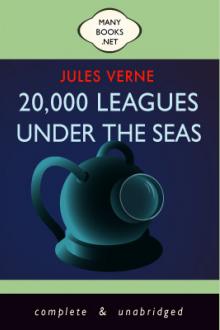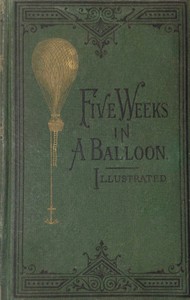The Mysterious Island, Jules Verne [inspiring books for teens TXT] 📗

- Author: Jules Verne
Book online «The Mysterious Island, Jules Verne [inspiring books for teens TXT] 📗». Author Jules Verne
“Nevertheless,” observed Pencroff, “he was not a brute when he wrote that paper, and if it is seven or eight years since it was thrown into the sea, how is it that the paper has not been injured by moisture?”
“It proves,” said Smith, “that Ayrton retained possession of his faculties to a period much more recent than he imagines.”
“That must be it,” replied Pencroff, “for otherwise the thing would be inexplicable.”
“Inexplicable, indeed,” answered the engineer, who seemed not to wish to prolong this talk.
“Has Ayrton told the truth?” questioned the sailor.
“Yes,” answered the reporter, “the history he has related is true in every particular. I remember, perfectly well, that the papers reported Lord Glenarvan’s undertaking and its result.”
“Ayrton has told the truth,” added Smith, “without any doubt, Pencroff, since it was trying enough for him to do so. A man does not lie when he accuses himself in this way.”
The next day—the 21st—the colonists went down to the beach, and then clambered up to the plateau, but they saw nothing of Ayrton. The man had gone to his house the night before, and they judged it best not to intrude upon him. Time would, doubtless, effect what sympathy would fail to accomplish.
Herbert, Pencroff, and Neb resumed their accustomed occupations; and it happened that their work brought Smith and Spilett together at the Chimneys.
“Do you know, Cyrus, that your explanation of yesterday about the bottle does not satisfy me at all? It is impossible to suppose that this unhappy creature could have written that paper, and thrown the bottle into the sea, without remembering anything about it!”
“Consequently, it is not he who threw it there, my dear Spilett!”
“Then you believe—”
“I believe nothing, I know nothing!” replied Smith, interrupting the reporter. “I place this incident with those others which I have not been able to explain!”
“In truth, Cyrus,” said Spilett, “these things are incredible. Your rescue, the box thrown up on the beach, Top’s adventures, and now this bottle. Will we never have an answer to these enigmas?”
“Yes,” answered the engineer, earnestly, “yes, when I shall have penetrated the bowels of this island!”
“Chance will, perhaps, give us the key to this mystery.”
“Chance, Spilett! I do not believe in chance any more than I believe in mystery in this world. There is a cause for everything, however inexplicable, which has happened here, and I will discover it. But, while waiting, let us watch and work.”
January arrived, and the year 1867 began. The works had been pushed forward vigorously. One day Herbert and Spilett, passing the corral, ascertained that Ayrton had taken possession of his abode. He occupied himself with the large herd confided to his care, and thus saved his companions the necessity of visiting it two or three times a week. Nevertheless, in order not to leave Ayrton too much alone, they frequently went there.
It was just as well—owing to certain suspicions shared by Smith and Spilett—that this part of the island should be under a certain supervision, and Ayrton, if anything happened, would not fail to let the inhabitants of Granite House know of it.
Possibly, some sudden event might happen, which it would be important to communicate to the engineer without delay. And, aside from whatever might be connected with the mystery of the island, other things, requiring the prompt intervention of the colonists, might occur, as, for example, the discovering of a ship in the offing and in sight of the west coast, a wreck on that shore, the possible arrival of pirates, etc.
So Smith determined to place the corral in instant communication with Granite House.
It was the 10th of January when he told his project to his companions.
“How are you going to do such a thing as that, Mr. Smith?” asked Pencroff. “Maybe you propose to erect a telegraph!”
“That is precisely what I propose to do.”
“Electric?” exclaimed Herbert.
“Electric,” responded Smith. “We have everything necessary for making a battery, and the most difficult part will be to make the wires, but I think we can succeed.”
“Well, after this,” replied the sailor, “I expect some day to see us riding along on a railway!”
They entered upon the work at once, beginning with the most difficult part, that is to say, the manufacture of the wires, since, if that failed, it would be useless to make the battery and other accessories.
The iron of Lincoln Island was, as we know, of excellent quality, and, therefore, well adapted to the purpose. Smith began by making a steel plate, pierced with conical holes of different sizes, which would bring the wire to the desired size. This piece of steel, after having been tempered “through and through,” was fixed firmly to a solid frame-work sunk in the ground, only a few feet distant from the waterfall—the motive power which the engineer intended to use.
And, indeed, there was the fulling-mill, not then in use, the main shaft of which turned with great force, and would serve to draw out the wire and roll it around itself.
The operation was delicate and required great care. The iron, previously made into long and thin bars, with tapering ends, having been introduced into the largest hole of the drawing-plate, was drawn out by the main shaft of the mill, rolled out to a length of 25 or 30 feet, then unrolled, and pulled, in turn, through the smaller holes; and at length, the engineer obtained wires 30 or 40 feet long, which it was easy to join together and place along the five miles between the corral and Granite House.
It took but a little while to get this work under way, and then, Smith, making his companions the wire-drawers, busied himself in the construction of his battery.
It was necessary to make a battery with a constant circuit. We know that modern batteries are usually made of a certain kind of coke, zinc, and copper. Copper the engineer was without, since, in spite of all his efforts, he had been unable to find a trace of it on the island. The coke, which is that hard deposit obtained from gas retorts could be procured, but it would be necessary to arrange a special apparatus—a difficult thing to do. As to the zinc, it will be remembered that the box found on Jetsam Point, was lined with a sheet of that metal, which could not be better utilized than at present.
Smith, after deep reflection, resolved to make a very simple battery, something like that which Becquerel invented in 1820, in which zinc alone is used. The other substances, nitric-acid and potash, he had at hand.
The manner in which he made this battery, in which the current was produced by the action of the acid and the potash on each other, was as follows:—
A certain number of glass vessels were made and filled with nitric-acid. They were corked with perforated corks, containing glass tubes reaching into the acid, and stopped: with clay plugs, connected with threads. Into these tubes the engineer poured a solution of potash—obtained from burnt plants—and thus the acid and the potash reacted on each other through the clay.
Then Smith plunged two plates of zinc, the one in the nitric acid, the other in the solution, and thus produced a circuit between the tube and jar, and as these plates had been connected by a bit of wire, the one in the tube became the positive and the other the negative pole of the apparatus. Each jar produced its currents, which, together, were sufficient to cause all the phenomena of the electric telegraph.
On the 6th of February they began to erect the poles, furnished with glass insulators, and some days later the wire was stretched, ready to produce the electric current, which travels with the speed of 100,000 kilometres a second.
Two batteries had been made, one for Granite House, and the other for the corral, as, if the corral had to communicate with Granite House, it might, also, be needful for Granite House to communicate with the corral.
As to the indicator and manipulator, they were very simple. At both stations the wire was wrapped around an electro-magnet of soft iron. Communication was established between the two poles; the current, leaving the positive pole, traversed the wire, passed into the electro-magnet, and returned under ground to the negative pole. The current closed, the attraction of the electro-magnet ceased. It was, therefore, sufficient to place a plate of soft iron before the electro-magnet which, attracted while the current is passing, falls, when it is interrupted. The movement of the plate thus obtained, Smith easily fastened to it a needle, pointing to a dial, which bore the letters of the alphabet upon its face.
Everything was finished by the 12th of February. On that day Smith, having turned on the current, asked if everything was all right at the corral, and received, in a few moments, a satisfactory reply from Ayrton.
Pencroff was beside himself with delight, and every morning and evening he sent a telegraph to the corral, which never remained unanswered.
This method of communication presented evident advantages, both in informing the colonists of Ayrton’s presence at the corral, and in preventing his complete isolation. Moreover, Smith never allowed a week to pass without visiting him, and Ayrton came occasionally to Granite House, where he always found a kind reception.
Continuing their accustomed work, the fine weather passed away, and the resources of the colony, particularly in vegetables and cereals, increased from day to day, and the plants brought from Tabor Island had been perfectly acclimated. The plateau presented a most attractive appearance. The fourth crop of corn had been excellent, and no one undertook to count the 400,000,000,000 grains produced in the harvest; although Pencroff had had some such idea, until Smith informed him that, supposing he could count 300 grains a minute, or 18,000 an hour, it would take him 5,500 years to accomplish his undertaking.
The weather was superb, though somewhat warm during the day; but, in the evening, the sea-breeze sprung up, tempering the air and giving refreshing nights to the inhabitants of Granite House. Still there were some storms, which, although not long continued, fell upon Lincoln Island with extraordinary violence. For several hours at a time the lightning never ceased illuminating the heavens, and the thunder roared without cessation.
This was a season of great prosperity to the little colony. The denizens of the poultry-yard increased rapidly, and the colonists lived on this increase, as it was necessary to keep the population within certain limits. The pigs had littered, and Pencroff and Neb’s attention to these animals absorbed a great part of their time. There were too young onagers, and their parents were often ridden by Spilett and Herbert, or hitched to the cart to drag wood or bring the minerals which the engineer made use of.
Many explorations were made about this time into the depths of the Far West. The explorers did not suffer from the heat, as the sun’s rays could not penetrate the leafy roof above them. Thus, they visited all that part to the left of the Mercy, bordering on the route from the corral to the mouth of Fall River.
But during these excursions the colonists took care to be well armed, as they often encountered exceedingly savage and ferocious wild boars. They also waged war against the jaguars, for which animals Spilett had a special hatred, and his pupil, Herbert, seconded him well. Armed as they were, the hunters never shunned an encounter with these beasts, and the courage of Herbert was superb, while the coolness of the reporter was astonishing. Twenty magnificent skins already ornamented the hall at Granite House, and at this rate the jaguars would soon be exterminated.
Sometimes the engineer took part in explorations of the unknown portions of the island, which he observed with minute attention. There were other traces than those of animals





Comments (0)